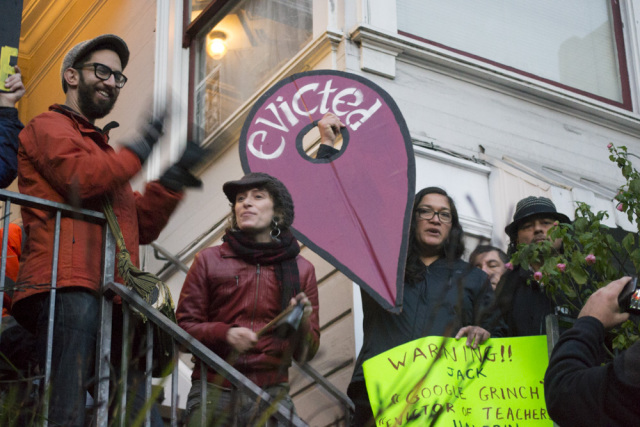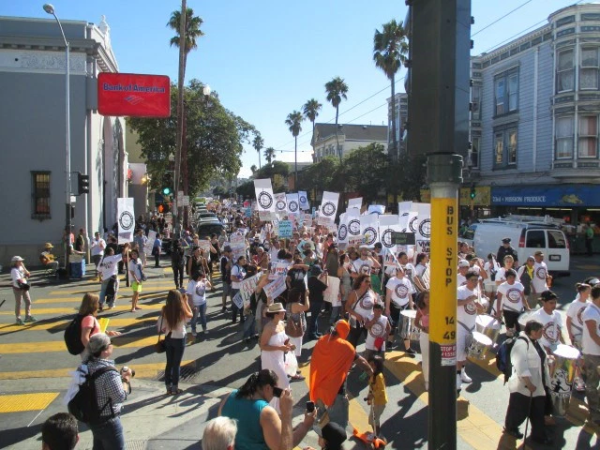Editor’s note: We are joining with other news media to talk about homeless issues this week. We’ve looked at why there are so many people living on the streets and what life is really like for homeless people. In this piece, Jennifer Freidenbach, director of the Coalition on Homelessness, talks about how we start to solve the problem of people forced to live on the streets.
The Homeless Emergency Service Providers Union has put together a budget proposal and plan that would make a huge dent in the problem. The budget proposal asks for $13.5 million in new and baseline funding for next year.

What would that money pay for? Here are the key things
- Develop a sustainable revenue source for housing, housing, housing
It’s less expensive to house homeless people then to keep them homeless; we spend more on health care, social services. and criminal justice while someone is homeless then we do on housing for them once they are housed.
We need to double the current number of homeless people being housed in SF. We can’t do this overnight, but we can’t put it off either. Currently we are spending about $70 million to house about 6,000 people. About half of that housing is master lease, and the other half is permanent supportive housing. We can’t massively expand the master lease, because it relies on the current housing stock (We can probably expand master lease by about 300 units). We have to rely on construction, rehab and acquisition — we can get creative with pre fab buildings etc to bring down the price, but this endeavor is achievable. We just need a sustainable revenue source to do this. We currently spend less than 3 percent of the city budget towards this issue.
Currently, our housing for homeless people has taken a nose dive. Between now and 2022, we are only going to build 632 new units for homeless people. Compare that to 2008-2014 where we did 2,790 units for homeless people. We decreased the numbers and stopped having 100% homeless buildings, which is a mistake.
If we think things are bad now…..
- No new jail – but community mental health
While the number of people in SF county jail has plummeted, the number of people with mental illnesses in jail has stayed the same. With the halting of the construction of a new jail, there is an opportunity to keep jail numbers down by addressing fundamental issue of mental health. There is also capital money available. There are lots of different ideas for this, but pretty much all areas of the mental health system are in trouble and need expanded capacity. This includes community crisis hospital diversion sites like Dore Urgent Care Clinic, which has to turn people away with alarming frequency; residential treatment – which only a select few can access — and outpatient services. Many of us are thinking about a large mixed use facility that addresses multiple needs, and acts as a pre-arrest diversion instead of a jail.
- Shifting the status quo from a police response to smart solutions
The status quo for San Franciscans if they have a homeless neighbor or encampment is to call the city, which most of the time sends police officers (or doesn’t respond at all). The police move the person maybe across the street, or a block away, and another complaint is generated.
Or the person is issued a ticket (27,000 were given out last year 9,000 more than anytime that it was previously recorded). Rarely are any services offered, and even on those rare occasions that the city sends an outreach worker, there is rarely housing or treatment available.
In cities like Cleveland, outreach workers are sent, not police. If we do the first two items on this list, we will have the resources to get people off the streets instead of just shuffling them around as their health and mental health deteriorates.
We have to force city officials to change the frankly lazy way they address this issue. They let an encampment grow until it generates a ton of complaints, then remove it by pushing people a block away. We should have actual planning — a relocation plan — so we solve the issue, and don’t just pretend to for political gain.
We have a robust $7 million homeless outreach team budget, but no housing or treatment to place folks in.
The Obama Administration has issued guidelines for addressing encampments. We have legislation pending that would force the city to be both accountable to campers/neighbors, and more thoughtful about how encampments are addressed with a trajectory towards solutions as opposed to shuffling people around.
- Better use of public housing
Public housing has to be a fundamental part of the solution to homelessness. We have to get creative to move homeless people quickly into these units. Public housing is getting rebuilt, and both units in the affordable housing pipeline for homeless people and public housing units that are vacant are being held for relocation of rehabbed public housing units. Once that process is over, and it should be expedited, we can move homeless people into vacant units.
- Keeping San Franciscans housed — prevention
We have to close that front door into homelessness. By and large, it is San Franciscans that make up our homeless population. We need to halt that by ensuring folks stay in their rent controlled housing. We know how to do this as well. The budget proposal would cover eviction defense for 450 at-risk households, tenant outreach to 89,000 renters, back rent for 60 homeless families and a mediation program for 450 public housing tenants.
- Jobs
We are weak on this front — and about to lose the little that we have. The federal government just cut the little funding we had for job training for homeless people.
- Navigation centers
We need to bring the lessons of the navigation centers city wide.
- Quickly housing San Franciscans
We can use short-term and private-market subsidies to rapidly house homeless people, and have had tremendous success doing that. Our budget proposal would house another 370 households. Using the city budget process to get these funded has worked well in the past – we have housed hundreds of homeless people this way.
Folks working on these issues know what the solutions are; what we are lacking is political will.





